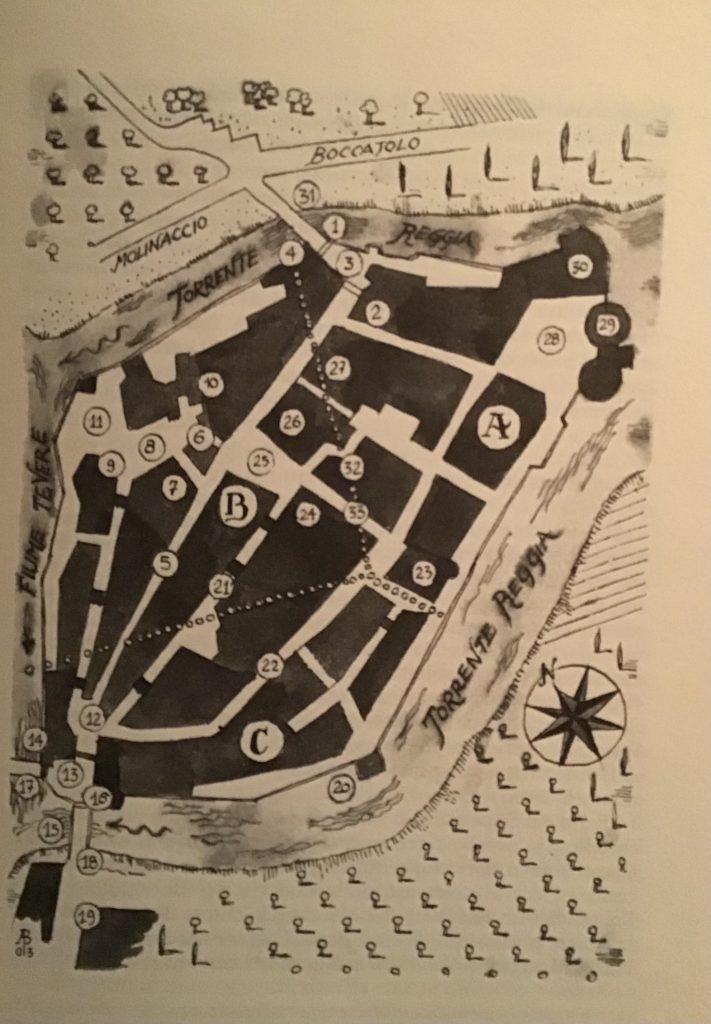I’ve been meaning to get back to posts about Umbertide. I love to try to picture how it used to be in, say the 1700s. Of course, it was very different. For one thing, there was water on all sides. We already have the Tevere or the Tiber river. I’m told it was much bigger in the past. Maybe that was because it wasn’t penned in like it is today. We had mills and the water ran them. We also have the torrente Reggia which is a smaller stream which also runs near the city walls to the south. It is very small now, but again, I am told it was larger. Not only that but, back then, it split into two branches and one ran along the northern side of the wall as well. Both of the smaller streams emptied into the river. Effectively the town was surrounded by water.
I have a book called Umbertide nel Secolo XVIII. This copy of a map from the 1700s was in it. I will do a key under it. I had a lot of fun translating many of the locations. Some don’t exist anymore, like the gates and towers, but Umbertide put up little brass plaques at most of the relevant places. Surprisingly most buildings and the piazze do exist. On the map the top branch of the Torrente Reggia ran just behind our house along the walls. I also noted the town was divided into three parts: A = Terziere superiore, B = Teziere di mezzo, and C = Terziere inferiore. I live in the mezzo.

I’m not going to translate all of the words. But a number of them recur and also alot of them are names of people, names of streets, etc. So, a few recurring ones are: Porta which means door but in this case I am pretty sure it means Gate. Umbertide had gates into if from all sides for safety. Torrione means big tower. Torre means tower. Strada means street as does Via. Vicolo is alley or small street. Chiesa is a church. Piazza is a square, Piazzetta means little square. Palazzo is a big house. Ponte is a bridge.
| 1. Porta della paiggiola | 18. Ponte sul torrente Reggia |
| 2. Controporta della Campana Sormontata da una toretta con l’orologio e dalla campana publica che batteva le ore | 19. Inizio della strada che conduce a Piazza San Francesco |
| 3. Piazzetta inter portas, o della Campana | 20. Torre di difesa di sud est costruita nel 1480 |
| 4. Torrione circolare a lato della Porta della Piaggiola | 21. Strada di mezzo, gia Via del Pomo, poi Via Mariotti |
| 5. La Via Regale o Via Diritta. Congiungeva la piazzetta della Campana con il baluardo di sud ovest | 22. Strada di San Giovanni |
| 6. La Chiesa Nuova voluta dalla famiglia Magi Spinetti unita alla loro casa da un soprapassaggio (anno 1710 circa) | 23. Chiesa di San Giovanni |
| 7. Vicolo della Chiesa Nuova | 24. Monte Frumentario: si trovava sulla Piazza del Marchese |
| 8. Piazzetta delle Petresche | 25. Piazza del Marchese o Piazza del Grano |
| 9. Vicolo delle Petresche | 26. Palazzo del marchese di Sorbello construito all’inizio del secolo. |
| 10. Convento dei Padri Cappuccini di Montone | 27. Il “Foricchio”, era un passaggio pedonale coperto che metteva in comunicazione la Via Diritta con il cortile interno del Palazzo di Sorbello |
| 11. Piazzetta dello Steccato. Basamento antico torrione | 28. Piazza del Comune, detta anche Piazza della Rocca |
| 12. Piazzetta di Sotto | 29. La Rocca |
| 13. Piazzetta inter portas. Sul lato nord sorgeva la casa Vibi | 30. Palazzo Comunale. Al primo piano c’era la Sala del Consiglio che veniva ceduta anche all’Accademia dei Signori Riuniti per rappresentazioni teatrali |
| 14. Porta del ponte sul Tevere | 31. La Piaggiola |
| 15. Lo scortico o pubblico macello spora le mura castellane per scaricare nel Tevere i residui della macellaazione. | 32. Vicolo degli Scodellari o dei Vasellari |
| 16. Torrione decagonale di difesa del baluardo di sud ovest | 33. Altra strada detta “Via di Mezzo” |
| 17. Ponte sul Tevere |
I have another map that takes in the area north of the city, or just behind our house. I’ll post that one another time.
~~~~~~~~
Italiano phrase — “cosa c’è per cena stasera?” — English “what’s for dinner tonight?” Pronounced, cos-ah chay pear chain-ah stah-sara.
~~~~~~~
Stay safe everyone! 🌈
